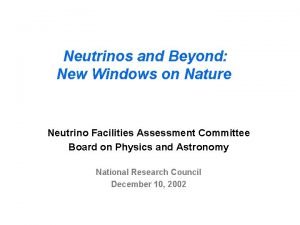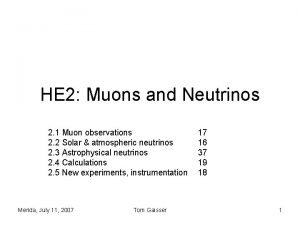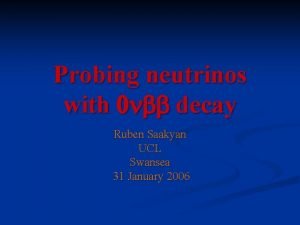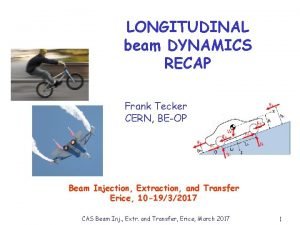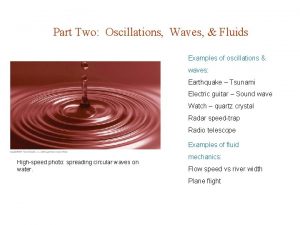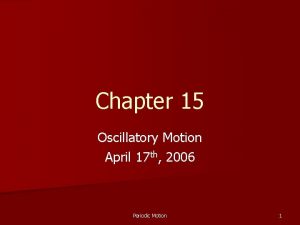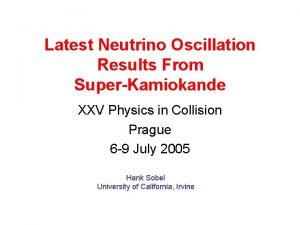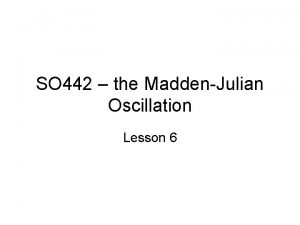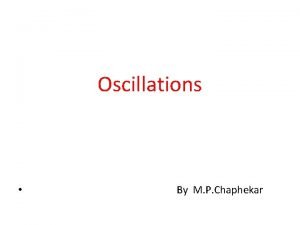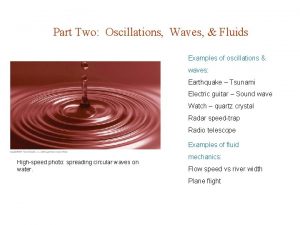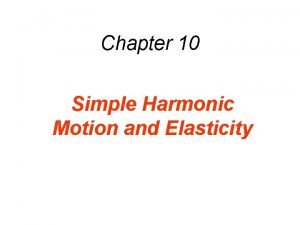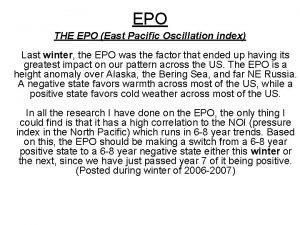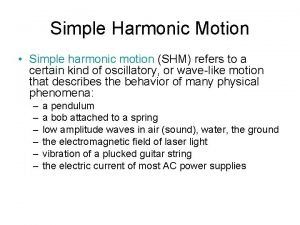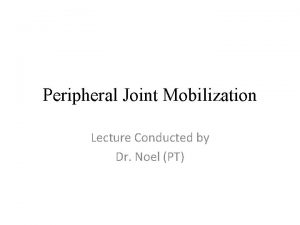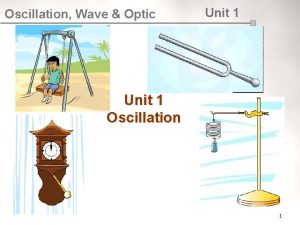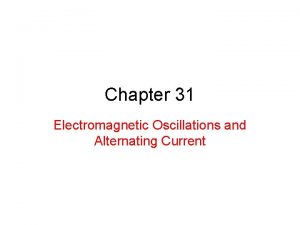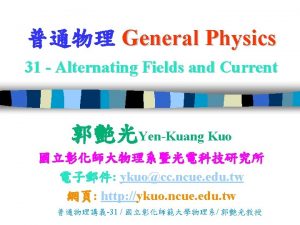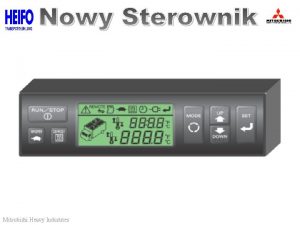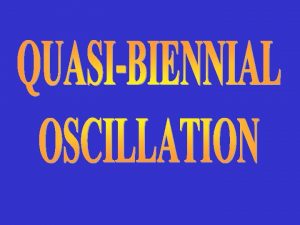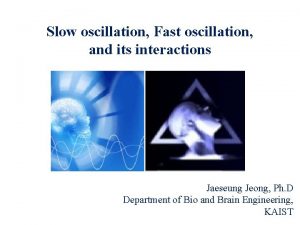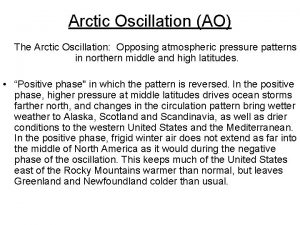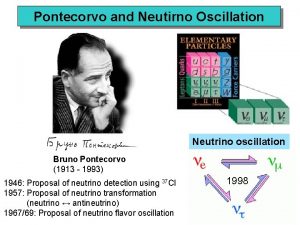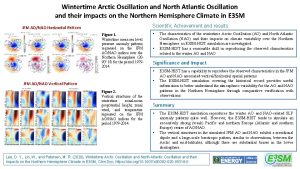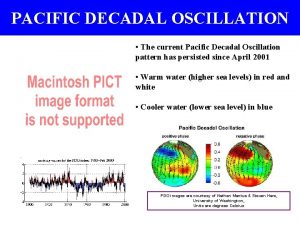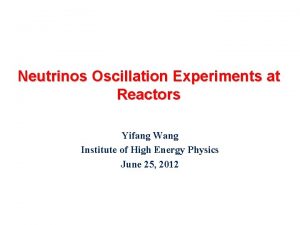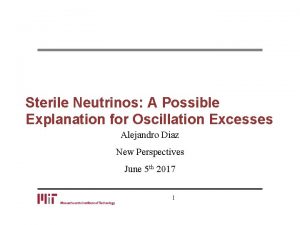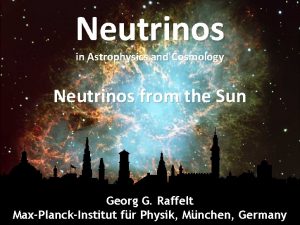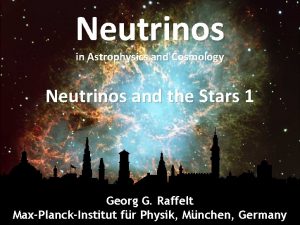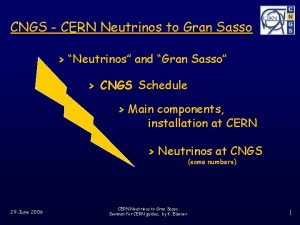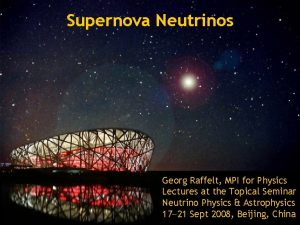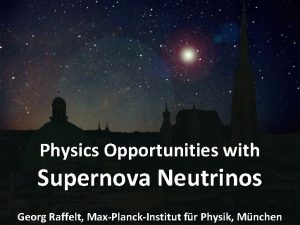Heavy neutrinos effects for oscillation of light neutrinos
























- Slides: 24

Heavy neutrinos effects for oscillation of light neutrinos at short distances V. V. Khruschov 1, 2*), S. V. Fomichev 1, 3**) 1) National Research Centre Kurchatov Institute, Academician Kurchatov Place 1, Moscow, 123182 Russia 2) Center for Gravitation and Fundamental Metrology, VNIIMS, Ozernaya Street 46, Moscow, 119361 Russia 3) Moscow Institute of Physics and Technology (State University), Institutskii Lane 9, Dolgoprudnyi, Moscow Region, 141700 Russia ICPPA 2017, October 2 -5, 2017, Moscow

Standard Model (SM) and Minimally Extended Standard Model • Neutrinos entered in the SM as particles with zero masses, so it is necessary to extend SM and provide them with different mass values in order to account for neutrino oscillations. This generalization of the SM is commonly named as the Minimally Extended Standard Model (MESM). However in the MESM framework the set of particles is the same as in the SM framework.

Standard Model (SM) and Minimally Extended Standard Model • Now the problem of new particles additional to the SM (or the MESM) is amongst the most important problems of the modern particle physics. New particles are needed for numerous models beyond the SM and they include sterile neutrinos (SNs), heavy neutrinos (HNs) and dark matter particles (DMPs) (see, e. g. , K. N. Abazajian et al. , ar. Xiv: 1204. 5379; M. Demianski and A. G. Doroshkevich, ar. Xiv: 1511. 07989 v 6).

Minimally Extended Standard Model (MESM), SNs and HNs

SBL neutrino anomalies

HNs and DMPs

Generalized neutrino model with SNs and HNs • We use the principle of symmetry for a generalization of the MESM and an inclusion of SNs and HNs in the phenomenological model. One can find the left-right symmetry SU(2)x. SU(2) (Pati-Salam, Phys. Rev. , D 10, 275, 1974) or the new left symmetry SO(10) (Khruschov, ar. Xiv: 1609. 01858, 2016). In the former case we have three SNs additional to the MESM particles, in the latter four SNs and HNs.

Generalized neutrino model with SNs and HNs • The model with three SNs and its use for the flavor transformation of neutrino fluxes in a supernova were considered in Refs. : Zysina. Fomichev-Khruschov, Ph. Atom. Nucl. 77, 890, 2014; Khruschov-Fomichev-Titov, Ph. Atom. Nucl. 79, 483, 2016; Khruschov-Yudin. Nadyozhin-Fomichev, Astron. Lett. 41, 260, 2015; Yudin-Nadyozhin-Khruschov. Fomichev, Astron. Lett. 42, 800, 2016.

Generalized neutrino model with SNs and HNs • Below we consider the effects of HNs in the framework of the model with three SNs for oscillations of active neutrinos at shot distances, as well as the same effects in the framework of the more general model with four SNs and HNs. Let us note that the former case with three SNs is easily included in the latter case with four SNs and HNs.

The 16 -dimensional representation of the SO(10) group with SNs and HNs (Khruschov, ar. Xiv: 1609. 01858)

Generalized neutrino model with SNs and HNs

The generalized Pontecorvo. Maki-Nakagava-Sakata matrix

The generalized Pontecorvo-Maki. Nakagava-Sakata matrix

The generalized Pontecorvo. Maki-Nakagava-Sakata matrix

The generalized Pontecorvo-Maki. Nakagava-Sakata matrix

The generalized Pontecorvo-Maki. Nakagava-Sakata matrix

The neutrino masses

The amplitudes of neutrino propagation in vacuum • The equations for the flavor amplitudes of neutrino propagation in vacuum are well known (see, e. g. , Khruschov-Fomichev. Titov, Ph. Atom. Nucl. 79, 483, 2016). Moreover analytical expressions are known (S. M. Bilenky, Phys. Part. Nucl. Lett. 12, 453, 2015), which can be used to control the accuracy of numerical results.

Appearance probability for electron neutrinos and antineutrinos in beams of muon neutrinos/antineutrinos in the framework of the model with three SNs

Appearance probability for electron neutrinos and antineutrinos in beams of muon neutrinos/antineutrinos in the framework of the model with four SNs and HNs (LMO version)

Appearance probability for electron neutrinos and antineutrinos in beams of muon neutrinos/antineutrinos in the framework of the model with four SNs and HNs (HMO version)

CONCLUSION • The probability amplidudes of oscillations in vacuum of light active neutrinos with account of the effects of sterile and heavy neutrinos have been calculated using three SNs option and four SNs and HNs option of the model and the new parameterization of the mixing matrix. • The great advantage of the considered cases lie in the revealing of the asymmetry between the appearance probabilities for electron neutrinos

CONCLUSION • and antineutrinos due to another source of the CP-noninvariance as compared with the MESM. The obtained excess and assymetry for electron neutrinos and antineutrinos can explain the appearance of the LSND anomaly. • The considered model may also be used to describe some astrophysical data for the cases where HNs are involved.

THANK YOU for your attention
 Neutrinos
Neutrinos Neutrinos
Neutrinos Neutrinos
Neutrinos Shratey
Shratey Light light light chapter 23
Light light light chapter 23 Light light light chapter 22
Light light light chapter 22 Chapter 22
Chapter 22 What is the amplitude of the oscillation
What is the amplitude of the oscillation Forced oscillation
Forced oscillation Damped oscillation
Damped oscillation Bifilar oscillation is the example of mcq
Bifilar oscillation is the example of mcq Oscillation
Oscillation Periodic motion
Periodic motion Julian oscillation
Julian oscillation Damped oscillation
Damped oscillation Grades of mobilization
Grades of mobilization Oscillation
Oscillation Damped oscillation
Damped oscillation Eastern pacific oscillation
Eastern pacific oscillation Oscillation of spring
Oscillation of spring Climate change definition
Climate change definition Non-thrust oscillation techniques
Non-thrust oscillation techniques Units for period of a pendulum
Units for period of a pendulum Electromagnetic oscillation pdf
Electromagnetic oscillation pdf Rlc oscillation
Rlc oscillation
